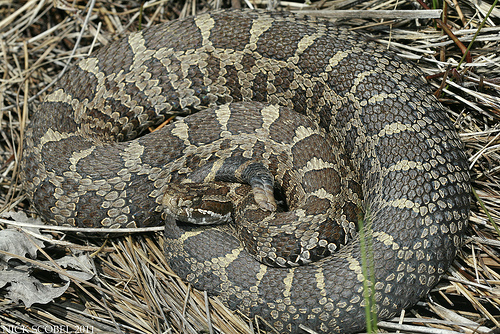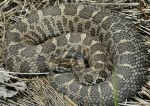 A deadly threat has been identified in a Southern Illinois population of Massasauga rattlesnakes (Sistrurus catenatus). In 2008, biologists found 3 eastern massasaugas with disfiguring lesions on and around their head. In addition, the snakes had multiple growths and ulcers, and experienced swelling that extended throughout the skin and skeletal muscle. Another massasauga with a similar condition was documented in the same area in 2010. Unfortunately, all snakes died. Cultures taken from infected individuals identified the disease causing pathogen as Chrysosporium, a soil dwelling fungus commonly found in pet reptiles but rarely seen in the wild. To date, Chrysosporium has also been documented in Timber rattlesnakes (Crotalus horridus) in Massachusetts and New Hampshire.
A deadly threat has been identified in a Southern Illinois population of Massasauga rattlesnakes (Sistrurus catenatus). In 2008, biologists found 3 eastern massasaugas with disfiguring lesions on and around their head. In addition, the snakes had multiple growths and ulcers, and experienced swelling that extended throughout the skin and skeletal muscle. Another massasauga with a similar condition was documented in the same area in 2010. Unfortunately, all snakes died. Cultures taken from infected individuals identified the disease causing pathogen as Chrysosporium, a soil dwelling fungus commonly found in pet reptiles but rarely seen in the wild. To date, Chrysosporium has also been documented in Timber rattlesnakes (Crotalus horridus) in Massachusetts and New Hampshire.
Although extremely rare, this is not the first time a fungus has been documented in wild snakes. In 1979, Williams and colleagues published a report regarding Phycomycosis in a wild massasauga. The snake was found with a severe facial fungal infection that resulted in death. Swelling throughout the body, penetrating deep into skeletal muscle was observed. Unfortunately, no culture was taken to positively identify the specific pathogen; thus, if the fungus identified in this species in 1979 is the same seen recently is unknown.
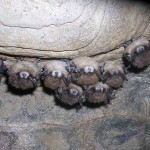 Fungal pathogens have also recently been identified as causing complete population collapses in other species, specifically in bats and amphibians. Geomyces destructans, or White-nose fungus, has been decimating bat populations throughout North America. Although no disfiguring tumors have been seen in bats, a white fungus grows on infected individuals around the nose and mouth. Bats with white-nose fungus are found emaciated with a degradation in wing membranes; mortality is 100%. Amphibian populations have been in rapid decline, with several species now extinct, from Batrachochytrium dendrobatis or
Fungal pathogens have also recently been identified as causing complete population collapses in other species, specifically in bats and amphibians. Geomyces destructans, or White-nose fungus, has been decimating bat populations throughout North America. Although no disfiguring tumors have been seen in bats, a white fungus grows on infected individuals around the nose and mouth. Bats with white-nose fungus are found emaciated with a degradation in wing membranes; mortality is 100%. Amphibian populations have been in rapid decline, with several species now extinct, from Batrachochytrium dendrobatis or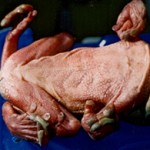 chytrid infection. Chytrid attacks the skin of frogs and causes it to become thick. Amphibian respiration is unique wherein it occurs through the skin. By causing the skin to thicken, chytrid essential causes the infected individual to suffocate within its own body. Regardless of infection or species, treatment of affected individuals has not been successful.
chytrid infection. Chytrid attacks the skin of frogs and causes it to become thick. Amphibian respiration is unique wherein it occurs through the skin. By causing the skin to thicken, chytrid essential causes the infected individual to suffocate within its own body. Regardless of infection or species, treatment of affected individuals has not been successful.
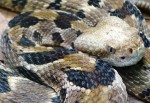 Although a direct cause of Chrysosporium among rattlesnakes has not yet been identified, one cannot help but think humans may have a hand in the spread of this pathogen. It is no secret that habitat is being destroyed at an alarming rate. Those rattlesnakes that escape persecution out of fear are forced to live in close quarters with others. By pushing animals into a smaller habitat, more individuals may come into contact with those infected. Additionally, it is interesting that Chrysosporium has been identified as common in pet reptiles. As the release of unwanted reptiles into the wild becomes more common place, one cannot help but wonder if this increase in infection is yet another casualty of the pet trade.
Although a direct cause of Chrysosporium among rattlesnakes has not yet been identified, one cannot help but think humans may have a hand in the spread of this pathogen. It is no secret that habitat is being destroyed at an alarming rate. Those rattlesnakes that escape persecution out of fear are forced to live in close quarters with others. By pushing animals into a smaller habitat, more individuals may come into contact with those infected. Additionally, it is interesting that Chrysosporium has been identified as common in pet reptiles. As the release of unwanted reptiles into the wild becomes more common place, one cannot help but wonder if this increase in infection is yet another casualty of the pet trade.
